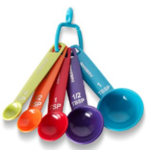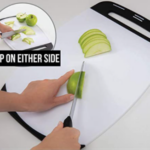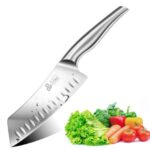Today, I’m thrilled to share with you my all-time favorite recipe for a Homemade Asian Dipping Sauce!
This isn’t just any sauce; it’s a magical blend of flavors that will dance on your palate and elevate your dishes to a whole new level.
Whether you’re drizzling it over dumplings, jazzing up your spring rolls, or just using it as a dip for your favorite snacks, this sauce is a game-changer!
So, let’s dive into the world of flavors and create our very own Asian Dipping Sauce symphony!
Post contains affiliate links and we earn commissions if you shop through the links on this page, including Amazon Associate links. For more information please read the disclaimer on the Privacy Policy page.
This Homemade Asian Dipping Sauce is incredibly versatile and pairs beautifully with a wide range of dishes. Here are some tantalizing ideas for using this sauce:
Dumplings and Gyoza
This sauce is a match made in heaven for both steamed and pan-fried dumplings. The savory and slightly sweet flavors enhance the taste of the fillings.

Spring Rolls or Egg Rolls
Whether they’re fresh or fried, this sauce adds a delightful zing to spring rolls and to deep fried or baked egg rolls.

Sushi and Sashimi
A light drizzle over sushi or sashimi can bring out the depth of flavors in the fish.
Grilled Meats
Use it as a dipping sauce for grilled chicken, beef, or pork. It’s especially good with skewers or kebabs.
Vegetable Stir-Fries
Stir a bit into your vegetable stir-fries for an extra burst of flavor.
Rice and Noodle Bowls
Drizzle it over a bowl of steamed rice or noodles, topped with your choice of protein and veggies.
Asian Salads
Use it as a dressing for salads that include ingredients like cabbage, carrots, and bell peppers.
Tofu Dishes
Enhance the flavor of baked or fried tofu with a side of this dipping sauce.
Seafood
It pairs wonderfully with grilled shrimp or scallops.
Lettuce Wraps
A perfect addition to chicken or pork lettuce wraps for an extra kick of flavor.
This sauce is not only delicious but also a great way to add an Asian flair to everyday meals. Experiment with it, and you might find even more delightful pairings!
Ingredients in this Asian Dipping Sauce
Let’s embark on a culinary adventure to craft our very own Asian Dipping Sauce, a true masterpiece of flavors!
The journey begins with a generous 1/4 cup of soy sauce, laying a savory foundation that promises to captivate your taste buds.

To this, we add a playful 2 tablespoons of rice vinegar, introducing a zesty zing that brings the sauce to life.

Next, a tablespoon of sesame oil joins the mix, infusing our sauce with a rich, nutty aroma that’s utterly irresistible.
But what’s a masterpiece without a little excitement? A teaspoon of red pepper flakes is our answer, ready to add a spicy kick that you can adjust to suit your love for heat.
Sweeten the Sauce!
Sweetness tiptoes in with 2 tablespoons of honey, providing a delicate balance to the robust flavors.

And because we all know that garlic is the secret hero in any dish, a teaspoon of minced garlic is added, making everything indescribably better.

As we near the end of our flavor journey, a tablespoon of finely chopped green onion is sprinkled in, introducing a fresh, verdant note that sings of spring.
Finally, a teaspoon of sesame seeds is scattered atop, lending a delightful crunch that completes our sauce. Every ingredient plays its part in this symphony of flavors, coming together to create something truly magical.
Substitute Ingredients You Can Use…
you can easily substitute ingredients in the Asian Dipping Sauce recipe to suit your taste preferences or to work with what you have on hand. Here are some suggestions:
Soy Sauce Alternatives:
Tamari: A great gluten-free option with a similar flavor profile.
Coconut Aminos: Ideal for a soy-free and lower sodium alternative. It’s sweeter and less salty, so you may need to adjust the other ingredients accordingly.
Rice Vinegar Substitutes:
Apple Cider Vinegar: Offers a similar tangy flavor, though slightly sweeter.
White Wine Vinegar: A bit more acidic but can work in a pinch.
Sesame Oil Options:
Light Olive Oil: While it won’t provide the same nutty flavor, it’s a good neutral oil.
Canola or Vegetable Oil: Again, these are more neutral but can work if you don’t have sesame oil.
Red Pepper Flakes:
Fresh Chilies: Minced for a fresh and more intense heat.
Chili Powder: For a smoother blend of heat without the flakes.
Honey Alternatives:
Maple Syrup: Offers a different kind of sweetness and is vegan-friendly.
Agave Syrup: Another vegan option, though it’s sweeter than honey, so use it sparingly.
Garlic Modifications:
Garlic Powder: Use in smaller quantities as it’s more concentrated.
Green Onion Substitutes:
Chives: Similar in flavor and appearance.
Shallots: Finely minced for a more subtle taste.
Sesame Seeds:
Toasted Seeds: For a deeper flavor.
Skip Them: If you don’t have sesame seeds, the sauce will still be tasty without them.
Remember, when substituting ingredients, the flavor profile of the sauce may change slightly. Feel free to experiment and adjust the quantities to suit your taste. Enjoy creating your own unique version of this delicious sauce!
Making the Homemade Asian Dipping Sauce
Start by finding your favorite mixing bowl. Add in the soy sauce, rice vinegar, and sesame oil. This trio forms the base of our sauce – a delightful mix of savory, tangy, and rich flavors.
Spice it Up
Next, sprinkle in the red pepper flakes. Remember, you’re the conductor of this flavor symphony, so feel free to adjust the spiciness to your liking.
Sweet Harmony
Now, let’s sweeten things up! Drizzle in the honey and watch as it melds into the mixture, adding a perfect balance to the tang and heat.
Garlic’s Magic Touch
Add the minced garlic. It’s amazing how a small teaspoon can bring so much depth and warmth to our sauce.
Freshness Unveiled
It’s time for the green onion to take the stage. This isn’t just for color – it adds a freshness that lifts the sauce to new heights.
The Final Touch
Lastly, sprinkle in the sesame seeds. They bring a nutty crunch that makes every bite interesting.
Whisk and Wonder
Grab your whisk and blend all the ingredients together. As you mix, watch the ingredients combine and transform into a sauce that’s more than just the sum of its parts.
Flavor Fusion
Let the sauce sit for a bit. This allows the flavors to get to know each other, and trust me, the wait is worth it.
Storing Leftover Homemade Asian Sauce
You can store the leftover Asian Dipping Sauce in the refrigerator for future use. Here are some tips on storing and preserving the sauce.
Transfer the leftover sauce into an airtight container. Seal it tightly to prevent air from getting in, which can affect the quality of the sauce.
The sauce can be refrigerated for up to a week. Beyond that, its freshness and flavors may start to diminish.
It’s normal for the sauce to separate over time due to the different oil and liquid components. Simply give it a good stir before using it again to recombine the ingredients.
Some people find that the flavor of the sauce actually improves after it sits for a day or two, allowing the ingredients to meld together. So, feel free to make it in advance for an even more robust taste.
Consider labeling the container with the date you made the sauce to keep track of its freshness.
Before using the refrigerated sauce, let it come to room temperature or give it a quick stir to make sure it’s well-mixed. This way, you can enjoy the flavors just as much as when you first made it. Happy dipping!
Freezing the Leftover Sauce…
Freezing is a great way to extend the shelf life of your sauce if you don’t plan to use it within a week. Here are some tips for freezing and using the sauce…
Pour the sauce into a freezer-safe container or a freezer bag. Leave a little headspace in the container because liquids expand when frozen.
Write the date on the container or bag. This will help you remember how long the sauce has been in the freezer.
The sauce can be stored in the freezer for up to 3 months for optimal quality. It remains safe beyond that, but the quality might start to decline.
Using the Frozen Sauce
When you’re ready to use the sauce, thaw it in the refrigerator overnight. Avoid thawing at room temperature as this can lead to bacterial growth.
Once thawed, the ingredients might separate or the texture might change slightly. Give it a good stir or shake (if it’s in a bottle) to recombine the ingredients. If the sauce doesn’t return to its original consistency, you can heat it gently while stirring to help re-emulsify the ingredients.
Use the thawed sauce within a few days, and avoid refreezing it once thawed.
Remember, while freezing is a practical option for long-term storage, the best flavor and texture are always enjoyed when the sauce is fresh.

If you liked this recipe, check out my Applebee’s Chicken Wonton Recipe or my Egg Roll in a Cup Recipe!
Asian Dipping Sauce
As an Amazon Associate I earn from qualifying purchases.
Ingredients
- 1/4 cup soy sauce
- 2 tablespoons rice vinegar
- 1 tablespoon sesame oil
- 1 teaspoon red pepper flakes adjust to taste
- 2 tablespoons honey
- 1 teaspoon minced garlic
- 1 tablespoon finely chopped green onion
- 1 teaspoon sesame seeds
Instructions
- In a bowl, combine the soy sauce, rice vinegar, and sesame oil.
- Add the red pepper flakes to the mixture. Adjust the quantity based on your desired level of spiciness.
- Stir in the honey to add sweetness to the sauce.
- Add the minced garlic to enhance the flavor. You can adjust the amount based on your preference.
- Mix in the finely chopped green onion for a fresh and aromatic touch.
- Finally, sprinkle sesame seeds into the sauce for added texture and nuttiness.
- Whisk all the ingredients together until well combined.
- Allow the sauce to sit for a few minutes to let the flavors meld.
- Your Asian dipping sauce is now ready to be served with your favorite appetizers or dishes. Adjust the ingredients according to your taste preferences, and feel free to experiment with the ratios to achieve the perfect balance of sweet, savory, and spicy flavors. Enjoy!








